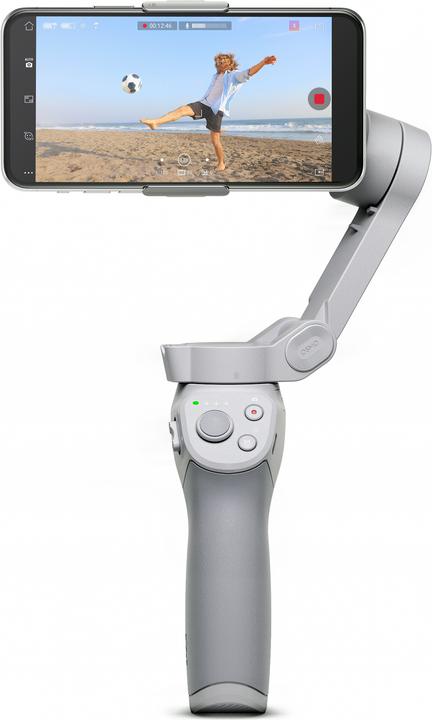
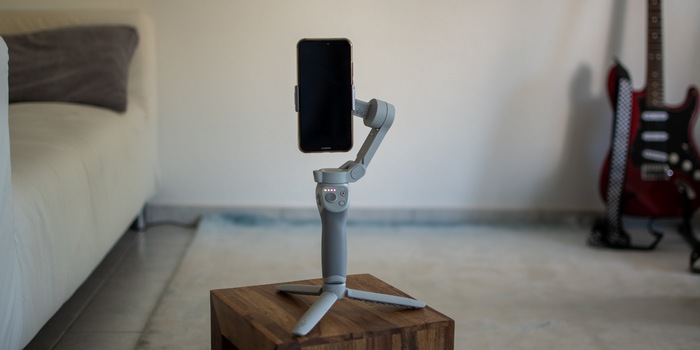
My experience with the DJI OM 4 gimbal
DJI has released a new version of the Osmo Mobile smartphone gimbal. It is now officially called DJI OM 4, and it calms video recordings and perhaps also the user. Ommmm ...
Before this test, I thought that a gimbal was a simple thing. Just a mount that stabilises the smartphone for video recordings. I can certainly test that, I thought, even though I don't know much about video producing with smartphones.
Shortly after unpacking, I was no longer so sure. The Quick Start Guide states: "Read the DJI Magnetic Ring Holder User Manual carefully to ensure that you use the ring holder properly." A separate user manual just for the magnetic ring holder? What is that anyway?

Magnetic ring what?
In contrast to its predecessor, the DJI Osmo Mobile 3, the smartphone is no longer clamped directly into the gimbal. Instead, the holder for the smartphone is a separate part that is attached to the gimbal with a strong magnet. Leaving this clamp on the smartphone makes it easier to attach and detach. However, I only do this if I know that I will need the gimbal again soon. This is because the clip covers the bottom side button if I place it correctly in the centre.
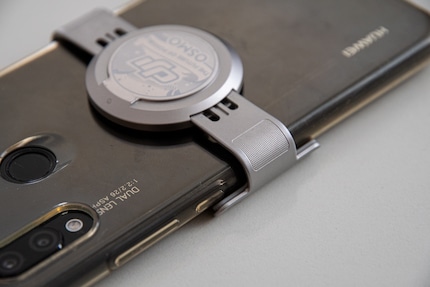
Instead of the clip, you can also attach the magnetic ring holder to the smartphone. This is permanently glued on, like a hook for a kitchen towel. In my case, this would solve the problem with the side button, but as I'm only testing the gimbal temporarily, I don't use the ring holder.
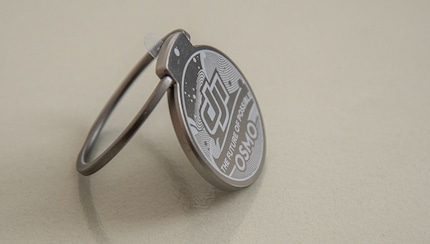
The ring can also be used as a smartphone stand, for example for video calls. For anyone who doesn't want eggbox craftsmanship.
Finally, the test
First, I install the associated DJI Mimo app. In principle, you can also take photos and videos with other apps. This is practical if you ever need a function that the DJI app doesn't offer. However, I need the DJI app to register, connect the gimbal to my smartphone and read the user manual. The Quick Start Guide is not very useful. The app also contains video tutorials. However, neither is in German, only in English.
The controls only work perfectly with the DJI app. In other apps - at least for me - the recording, zoom, orientation of the gimbal and switching between the front and rear camera all work. However, third-party apps do not respond to the mode button that switches between photo and video.
First, I film a few steps with and without the gimbal. There's no doubt about it: you need a gimbal to take these kinds of shots. The optical image stabilisation of a camera or even a smartphone could eliminate the small shaking movements, but not the larger movements. Even with the gimbal, the shaking caused by the steps remains faintly recognisable, but is not distracting. I think it's even better than if the shot looked as if the camera was on rails.
In the settings, you can tell the gimbal how it should stabilise. You can move your hand on three axes: The left-right movement, the up-down movement and the tilting movement from portrait to landscape format. By default, the gimbal only compensates for the last of the three axes. The gimbal follows the other movements smoothly and with some delay so that the shot is not too unsteady. In sports mode, the gimbal follows these movements more quickly.
The gimbal can also be set to correct upward and downward movements. The FPV setting follows all movements, including the tilting movement. The horizon then tilts like a GoPro shot of a bike lying in a bend.
This all works great. What doesn't work at all for me is the object tracking. With ActiveTrack 3.0, the DJI app is supposed to recognise a face or other object and the gimbal is then supposed to keep it in the centre of the image. The recognition works reasonably well, but the gimbal starts to rock and sway unmotivated until I am no longer in the picture.
In addition to this major annoyance, I also had two minor ones. The gimbal often holds the smartphone at a slight angle after removing and reattaching it. I can correct this in the settings by fine-tuning the alignment, but I have to do it again each time.
The other annoyance: I haven't found out how to deactivate or turn down the beeps of the gimbal and the app. They are sometimes practical, but sometimes too loud or even undesirable.
Fun with panoramas
I'm more into photography than video. No wonder I was particularly attracted by the possibilities of the panorama function.
In addition to the classic panorama, which extends over 240 degrees on the DJI OM 4, you can also compose an image from 3×3 photos. This creates an extremely wide-angle image. This works both horizontally and vertically. Vertically, I have often created almost square images, a few of which are quite impressive.
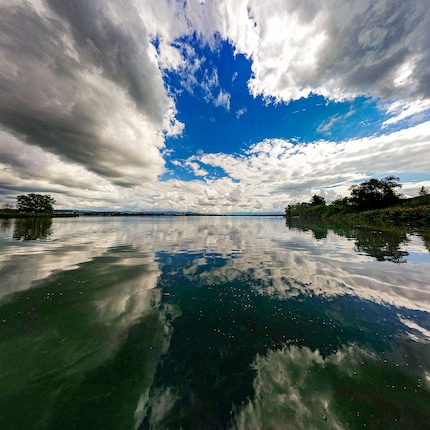
The above image has been slightly reworked in terms of colour and trimmed to a square shape. The original aspect ratio varies depending on the situation. This also applies to the resolution. In general, it is not higher than that of a normal photo. So you don't use the 3×3 Pano to create high-resolution images, but to get more in the picture.
I often captured both shady and sunny areas. These large differences in brightness are a problem. The app exposes all partial images in the same way, making the shadows appear practically black. Here is a comparison of the original image and the edited version with brightened shadows.
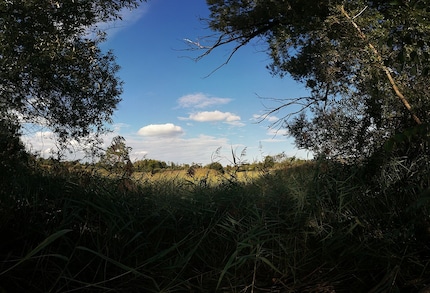
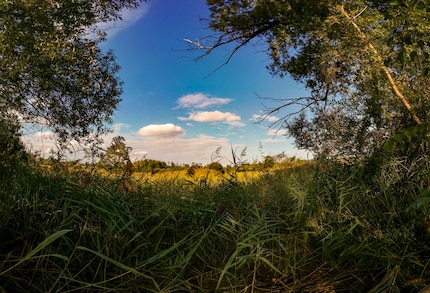
With the Clone-Me-Pano, you can display yourself multiple times in the same image. The app takes three individual images next to each other. As long as you don't position yourself exactly at the image transition, it comes out perfectly.
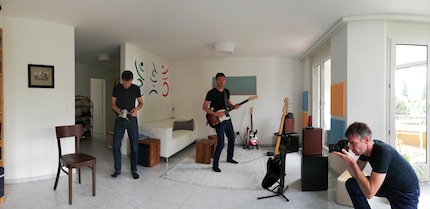
Time lapse, battery life and handling
The gimbal enables various types of time-lapse with and without movement. Here is a short test. In addition to simple camera pans, you can specify up to four positions that are to be controlled during the time-lapse.
The gimbal's battery is not a topic. According to the manual, it lasts 15 hours. However, the smartphone needs a lot of power during recording - its battery runs out much faster. It is therefore convenient that the gimbal can supply the smartphone with power. It can therefore also be used as a power bank. Just not during a recording, because the USB cable gets in the way when balancing.
The DJI OM 4 can be folded up when not in use and the stand is removable. DJI uses a standard tripod thread so that you can attach the gimbal to any photo tripod. This can be very useful because panos or time lapses require a solid base. And you can't always find a free surface at a suitable height.
Conclusion: Good except for the ActiveTrack
As a newcomer to the field, I can't compare the gimbal with others. Getting started was more difficult than I expected. But now that I understand how to use the OM 4, I find it practical. I only find the subject tracking unusable in this form.
Whether the gimbal is worthwhile for you also depends on your smartphone. Not every function is supported on all smartphones. You can find the details in this compatibility list.
My interest in IT and writing landed me in tech journalism early on (2000). I want to know how we can use technology without being used. Outside of the office, I’m a keen musician who makes up for lacking talent with excessive enthusiasm.


